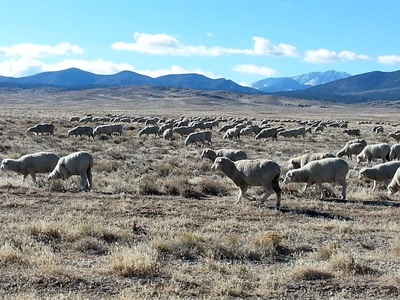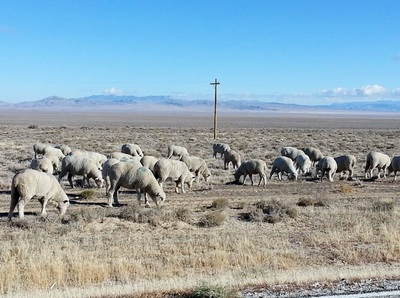I was on the road outside of Baker today and saw a large herd of sheep. Seeing this made me happy. I remember as a kid anytime we drove anywhere in NV there were always herds and herds of sheep, thousands of them. That isn't the case these days. The number of sheep raised in the country has really declined, which I think is a real shame.
There is usually just one sheep herder with the sheep and several dogs.
Fun Facts I looked up
As of Jan. 1, 2014, there were 5.21 million head of sheep in the
United States1
Nevada................80,000
Over the last 20 years, the number of sheep in this country has been cut in half. In fact, the number has been declining since the late 1940s, when the American sheep industry hit its peak. Today, the domestic sheep herd is one-tenth the size it was during World War II.
The decline is the result of economic and cultural factors coming together. And it has left ranchers to wonder, “When are we going to hit the bottom?”
Some sheep are raised for their wool, others primarily for food. Both products – lamb meat and wool – have seen declining consumption in the U.S. If you look at the tags on clothes in your closet, chances are quite a few pieces will be blended with synthetic fibers: nylon, rayon and polyester. As these human-made fibers have become more prevalent and inexpensive, people are wearing less and less wool.
The same goes for lamb. In the early 1960s the average person in the U.S. ate about 4.5 pounds of lamb in a year. That has dropped to less than a pound in 2011.
At the same time as the American sheep industry’s decline, Australian and New Zealand wool and lamb imports are way up, squeezing into niche markets that America’s sheep producers are having a hard time filling.
Ranchers are feeling the industry contraction, whether it’s caused by epic drought, scarce feed supplies, harsh winters, or wild price volatility.
Just a few things I read after seeing the sheep today, I guess the point is, eat more lamb and wear more wool.
As of Jan. 1, 2014, there were 5.21 million head of sheep in the
United States1
Nevada................80,000
Over the last 20 years, the number of sheep in this country has been cut in half. In fact, the number has been declining since the late 1940s, when the American sheep industry hit its peak. Today, the domestic sheep herd is one-tenth the size it was during World War II.
The decline is the result of economic and cultural factors coming together. And it has left ranchers to wonder, “When are we going to hit the bottom?”
Some sheep are raised for their wool, others primarily for food. Both products – lamb meat and wool – have seen declining consumption in the U.S. If you look at the tags on clothes in your closet, chances are quite a few pieces will be blended with synthetic fibers: nylon, rayon and polyester. As these human-made fibers have become more prevalent and inexpensive, people are wearing less and less wool.
The same goes for lamb. In the early 1960s the average person in the U.S. ate about 4.5 pounds of lamb in a year. That has dropped to less than a pound in 2011.
At the same time as the American sheep industry’s decline, Australian and New Zealand wool and lamb imports are way up, squeezing into niche markets that America’s sheep producers are having a hard time filling.
Ranchers are feeling the industry contraction, whether it’s caused by epic drought, scarce feed supplies, harsh winters, or wild price volatility.
Just a few things I read after seeing the sheep today, I guess the point is, eat more lamb and wear more wool.









 RSS Feed
RSS Feed